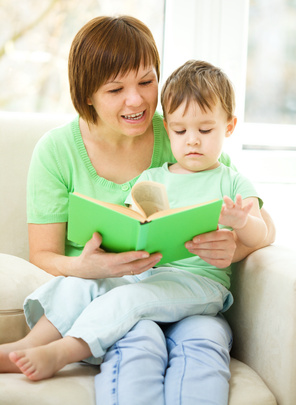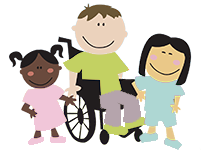It can be very bewildering for parents when a young child uses behaviors such as screaming, hitting and throwing objects to express anger or frustration. In the heat of the moment, it is very hard for a parent to feel confident of the right response. What will bring about the best behavior change? What might be a damaging response to a child’s tantrum?
Communication is the process of expressing or exchanging ideas, thoughts or feelings to another. Depending on the age or purpose of the intended message, the communicator may use speech, signs, print or behavior (to name a few) as a means of getting their message across to the listener. In the event that a child is using behavior to communicate, it is important to see if that is appropriate based on the child’s age.
 For instance, children under the age of 18 months typically have less than 20 single words and may just be developing the ability to say “no” in protest. Any time a child can’t verbalize their frustration, they may resort to other modes of communication, such as hitting or screaming or pushing away. Another aspect to consider with a child under the age of 18 months is whether he or she has developed a clear Theory of Mind (ToM), which is “the ability to attribute mental states to oneself and others and to understand that others have beliefs, desires, and intentions that are different from one’s own”. http://en.wikipedia.org/wiki/Theory_of_mind.
For instance, children under the age of 18 months typically have less than 20 single words and may just be developing the ability to say “no” in protest. Any time a child can’t verbalize their frustration, they may resort to other modes of communication, such as hitting or screaming or pushing away. Another aspect to consider with a child under the age of 18 months is whether he or she has developed a clear Theory of Mind (ToM), which is “the ability to attribute mental states to oneself and others and to understand that others have beliefs, desires, and intentions that are different from one’s own”. http://en.wikipedia.org/wiki/Theory_of_mind.
Certain skills, such as imitation, pointing and joint attention are foundational to Theory of Mind and typically develop by 12 months of age. Recent research suggests that toddlers as young as 16 months may be able to differentiate between a reliable communication partner and one who is unpredictable. This might indicate a beginning awareness that another person has different mental states than one’s own. It is important to consider this emotional/mental aspect of development when considering behaviors with young children because it could have a deciding impact on how a parent would respond to the behavior.
Under the age of 2 years, most toddlers will have the limited verbal ability to express frustration. Many times the best way to respond is by redirecting, labeling their feelings for them, labeling others feelings and modeling a good age-appropriate response. For example, let’s say Mom and Dad have just brought home a baby sister. Twenty month old Joey has mixed emotions, having been used to being number one! He picks up a toy and throws it at his sister (the toy thankfully bounces off the baby carrier, not her head). With a concerned (but not angry) voice, Mom could quickly come alongside Joey and say, “Throwing toys can hurt the baby!” “Joey, you’re angry and sad. Mommy and Daddy love you. We will take good care of you.” “Let’s give Sara a pat on the arm and then look at your Winnie the Pooh book”.
Obviously it would be a good idea to keep toys picked up in the general area and keep an eye on Joey when he is close to his new competition (that is his perspective) until he experiences that she isn’t a threat. Also, planning situations where you play with them both and help Joey “play” with sister by shaking a rattle for her or giving her a soft toy. Joey may not be to the point where he understands that he could cause his sister pain. He just wants things back to where they were or at least be assured that he is loved and still has a place of importance in the family dynamics.
By age two years, children start developing early perspective-taking skills, which refers to the ability to relate to others and see things from another’s perspective, though two-year-olds may often think others feel the same way they do (egocentric). At this age, a child can typically say 50 words and understands around 300 words. Receptive understanding is generally higher than expression. This is the age of commanding “move”; defiance, “No”; possessives, “Mine”; and reacting, “owee”. There are more temper tantrums at this age, somewhat related to difficulty with sharing and a desire to be independent. Again, strategies of redirecting, defining feelings and modeling appropriate language and behaviors can be helpful. Another good strategy at this age is offering choices. “I have put away the cookies, would you like some carrot sticks or an apple”. “It is time to turn off the TV, would you like some play-do or some crayons?” Choices models a good social strategy and also helps young children sense they can have some independence, within boundaries. Modeling good communication, and calmness are very important. Children at this age learn a great deal from watching others. So when you are upset, what do your children see?
Once a tantrum or destructive behavior has started, it might be useful to take some cues from functional analysis and look for the ABC’s, antecedent-behavior-consequences, in a given situation. Then analyze the results to determine how to help the child learn to communicate in a more acceptable manner.
Antecedent: What is happening to precede the behavior? Time of day, who is around, what kinds of activities (toys, meals, etc.)
Behavior: What actually happened? Did the child have a tantrum, hit someone, break a toy?
Consequence: In the ABC analysis, this refers to the purpose of the behavior; is a child trying to escape an overwhelming situation, avoid food, gain attention, or meet a sensory need?
Though functional analysis has been used for years with autism spectrum disorders, it is a useful way to pick up patterns in behaviors with anyone. The goal is to figure out the function of the child’s consequence: escape, avoidance, attention, sensory, and then chose an acceptable replacement behavior. For our purposes, this would be a better way for a child to communicate or a clearer receptive understanding of the situation.
For example, if your 3-year-old child tantrums as you get near the edge of the swimming pool, you would know the pool is probably the antecedent. The behavior is the tantrum. He is probably trying to escape the situation (move away from it) and avoid the situation (getting in the pool). So the consequence is escape and avoidance. What would be a good replacement behavior? Well, moving away from the edge of the pool in a slow casual way would be a good initial replacement behavior if it will stop the tantrum. Slow and casual so that it isn’t as obvious to the child that you are responding to their behavior (which can be reinforcing). Perhaps sitting by the wading pool for a while, with your feet in the water, to model the enjoyment of the activity. At the same time, using simple positive phrases about the water. “This feels so good”. I can touch the bottom!” “Look, I have a duck in the water! Can you put the other duck in the water?” “I like the pool!”
If a child has a pattern of using a particular behavior to meet a need, it is important to prepare a child before a new activity and model appropriate language for that situation.
So if you think your child may react the same way on the second visit to the pool, look at a few books on going to the pool and purchase a small wading pool for the backyard to play in for a while. Let the child play with the water hose. Talk about the pool. After working through some of these activities, give your child a choice. Would you like to go to the park or go swim with me and Grandma today? Give your child responses they can imitate. If they can’t say I am afraid of the pool, you can say, “You seem a little afraid of the pool.” “Is that right? Can you tell me?”
Over time, children will start using their words more to communicate if they have the words. And if they see that words are more effective than behavior.
On the other hand, a toddler’s antecedent may be seeing their favorite candy by the checkout stand. The behavior is trying to grab it and then screaming when you say “Not today”. The consequence would probably be attention-seeking and avoiding loss of the candy. The behavior you want to change is screaming when your child doesn’t get their way. So giving them the candy is never a good idea. It is better to ignore the behavior and let the screaming go on while you check out (if you can wait that long) or leave the store immediately, even if you have to come back later. The child has to see that the behavior did not get them the desired outcome. Later, when the child is calmed down, talk simply about how to act in the store. “Mommy doesn’t buy candy at the store while she pays. When Mommy says “No”, you must wait until we get home for a snack.” “Mommy will not be able to buy snacks if you can’t wait nicely in the buggy.” You may have to go through this several times depending on your child, but it is important to never give a reward for this kind of behavior.
With all children, it is important to model language for them and give them opportunities to practice saying “no” or practice accepting “no” at home so that they and you will be more equipped for the scenarios that have been described.
Children with intellectual challenges, such as ASD or Down syndrome or children with sensory challenges may need more support to cope. They have more difficulty pulling together what to say or may have more difficulty understanding what is going on. So again, it will be important to prepare them for new situations, with words, pictures and stories. Using a visual communication system can be helpful, even if it is just Yes/No and a few important pictures representing eat, drink, and restroom. Transitioning to augmentative communication will be helpful for those with limited verbal speech. Research indicates that augmentative communication does not slow verbal language development but can in fact increase verbalization. There are some great apps available for tablets that can be very helpful in transitions and for expressing wants.
With children with challenges, functional analysis is very important because it is very easy to reinforce behaviors un-intentionally, leading to more deeply impeded behavior routines. These children are more likely to have difficulty with ToM and perspective-taking, so they may continue on in behaviors longer and more frequently because they are more invested in getting their own need met as a result of fear, survival, or sensory modulation difficulties. They are less likely to see that others have their best interest at heart.
Pediatric speech therapists are experts in communication development. Understanding how important acceptable communication is for a positive childhood is a primary motivation for choosing a career with the pediatric population. If a family suspects behaviors are related to difficulty with understanding language or using language effectively, Speech & Occupational Therapy of North Texas will be happy to have a speech-language pathologist speak with you about your questions and concerns, free of charge.
For information on early childhood development of Theory of Mind visit http://psycnet.apa.org/?&fa=main.doiLanding&doi=10.1037/a0016715

Comments (0)